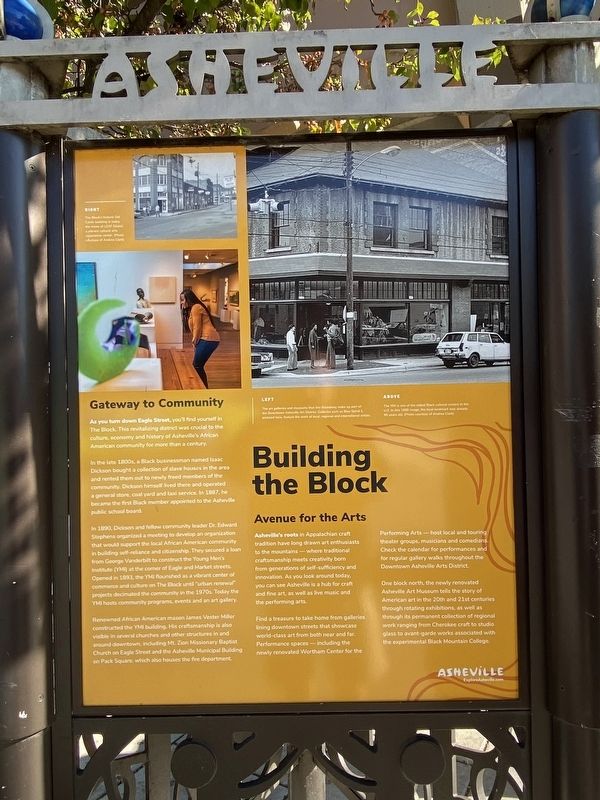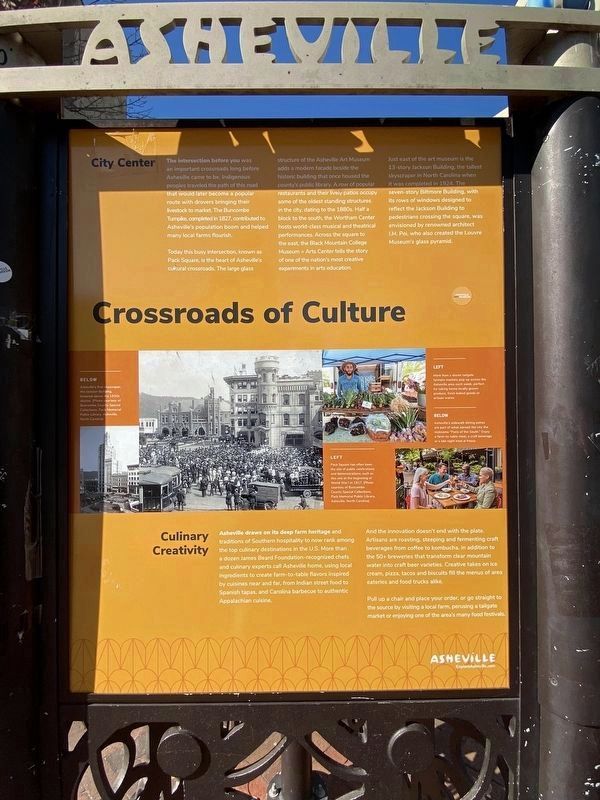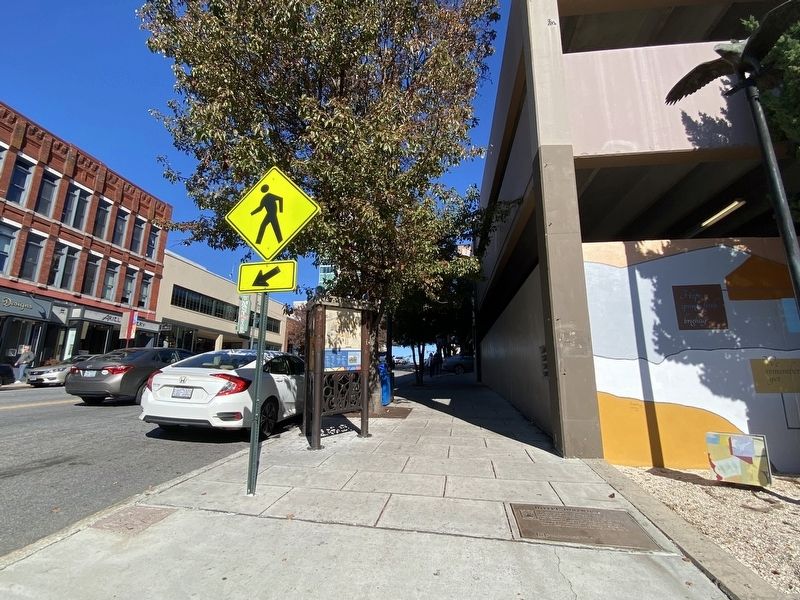Asheville in Buncombe County, North Carolina — The American South (South Atlantic)
Asheville
Building the Block / Crossroads of Culture
Building the Block
Gateway to Community
As you turn down Eagle Street, you'll find yourself in The Block. This revitalizing district was crucial to the culture, economy and history of Asheville's African American community for more than a century.
In the late 1800s, a Black businessman named Issac Dickson bought a collection of slave houses in the area and rented them out to newly freed members of the community. Dickson himself lived there and operated a general store, coal yard and taxi service. In 1887, he became the first Black member appointed to the Asheville public school board.
In 1890, Dickson and fellow community leader Dr. Edward Stephens organized a meeting to develop an organization that would support the local African American community in building self-reliance and citizenship. They secured a loan from George Vanderbilt to construct the Young Men's Institute (YMI) at the corner of Eagle and Market streets. Opened in 1893, the YMI flourished as a vibrant center of commerce and culture on The Block until "urban renewal" projects decimated the community in the 1970s. Today the YMI hosts community programs, events and an art gallery.
Renowned African American mason James Vester Miller constructed the YMI building. His craftsmanship is also visible in several churches and other structures in and around downtown, including Mt. Zion Missionary Baptist Church on Eagle Street and the Asheville Municipal Building on Pack Square, which also houses the fire department.
Avenue for the Arts
Asheville's roots in Appalachian craft tradition have one drawn art enthusiasts to the mountains - where traditional craftsmanship meets creativity born from generations of self-sufficiency and innovation. As you look around today, you can see Asheville is a hub for craft and fine art, as well as live music and the performing arts.
Find a treasure to take home from galleries lining downtown streets that showcase world-class art from near and far. Performance spaces - including the newly renovated Wortham Center for the Performing Arts - host local and touring theater groups, musicians, and comedians. Check the calendar for performances and for regular gallery walks throughout the Downtown Asheville Arts District.
One block north, the newly renovated Asheville Art Museum tells the story of American art in the 20th and 21st centuries through rotating exhibitions, as well as through its permanent collection of regional work ranging from Cherokee craft to studio glass to avant-garde works associated with the experimental Black Mountain College.
[Captions:]
Right: The Block's historic Del Cardo building is today the homes of LEAF Global, a vibrant cultural arts experience center. (Photo courtesy of Andrea Clark)
Left: The art galleries and museums that line Broadway make up part of the Downtown Asheville Art District. Galleries such as Blue Spiral 1, pictured here, feature the work of local, regional and international artists.
Above: The YMI is one of the oldest Black cultural centers in the U.S. In this 1988 image, the local landmark was already 95 years old. (Photo courtesy of Andrea Clark)
Crossroads of Culture
City Center
The intersection before you was an important crossroads long before Asheville came to be. Indigenous peoples traveled the path of this road that would later become a popular route with drovers brining their livestock to market. The Buncombe Turnpike, completed in 1827, contributed to Asheville's population boom and helped many local farms flourish.
Today this busy intersection, known as Pack Square, is the heart of Asheville's cultural crossroads. The large glass structure of the Asheville Art Museum adds a modern facade beside the historic building that once housed the county's public library. A row of popular restaurants and their lively patios occupy some of the oldest standing structures in the city, dating to the 1880s. Half a block to the south, the Wortham Center hosts world-class musical and theatrical performances. Across the square to the east, the Black Mountain College Museum + Arts Center tells the story of one of the nation's most creative experiment in arts education.
Just east of the art museum is the 13-story Jackson Building, the tallest skyscraper in North Carolina when it was completed in 1924. The seven-story Biltmore Building, with its rows of windows designed to reflect the Jackson Building to pedestrians crossing the square, was envisioned by renowned architect I.M. Pei, who also created the Louvre Museum's glass pyramid.
Culinary Creativity
Asheville draws on its deep farm heritage and traditions of Southern hospitality to now rank among the top culinary destinations in the U.S. More than a dozen James Beard Foundation-recognized chefs and culinary experts call Asheville home, using local ingredients to create farm-totable flavors inspired by cuisines near and far, from Indian street food to Spanish tapas, and Carolina barbecue to authentic Appalachian cuisine.
And the innovation doesn't end with the plate. Artisans are roasting, steeping and fermenting craft beverages from coffee to kombucha, in addition to the 50+ breweries that transform clear mountain water into craft beer varieties. Creative takes on ice cream, pizza, tacos and biscuits fill the menus of area eateries and food trucks alike.
Pull up a chair and place your order, or go straight to the source by visiting a local farm, perusing a tailgate market or enjoying one of the area's many food festivals.
[Captions:]
Below
Asheville's first skyscraper, the Jackson Building, towered above the 1920s skyline. (Photo courtesy of Buncombe County Special Collections. Pack Memorial Public Library, Asheville, North Carolina)
Left
More than a dozen tailgate farmers markets pop up across the Asheville area each week, perfect for taking home locally grown produce, fresh baked goods or artisan wares.
Below
Asheville's sidewalk dining patios are part of what earned the city the nickname "Paris of the South." Enjoy a farm-to-table meal, a craft beverage or a late night treat al fresco.
Left
Pack Square has often been the site of public celebrations and demonstrations, such as this one at the beginning of World War I in 1917. (Photo courtesy of Buncombe County Special Collections, Pack Memorial Public Library, Asheville, North Carolina)
Topics. This historical marker is listed in these topic lists: African Americans • Architecture • Industry & Commerce • Roads & Vehicles. A significant historical year for this entry is 1890.
Location. 35° 35.634′ N, 82° 33.077′ W. Marker is in Asheville, North Carolina, in Buncombe County. Marker is at the intersection of Biltmore Avenue (U.S. 25) and Eagle Street, on the right when traveling north on Biltmore Avenue. Touch for map. Marker is at or near this postal address: 2 Eagle St, Asheville NC 28801, United States of America. Touch for directions.
Other nearby markers. At least 8 other markers are within walking distance of this marker. Hotel District (a few steps from this marker); "The Block" (about 300 feet away, measured in a direct line); The Early Years In Asheville's Historic Central Square (about 400 feet away); Walk Into History (about 400 feet away); Crossroads of Culture (about 400 feet away); Crossroads (about 400 feet away); Brick Artisan (about 400 feet away); Zebulon Baird Vance (about 400 feet away). Touch for a list and map of all markers in Asheville.
Credits. This page was last revised on December 28, 2022. It was originally submitted on November 9, 2022, by Darren Jefferson Clay of Duluth, Georgia. This page has been viewed 154 times since then and 40 times this year. Photos: 1, 2, 3. submitted on November 10, 2022, by Darren Jefferson Clay of Duluth, Georgia. • Devry Becker Jones was the editor who published this page.


